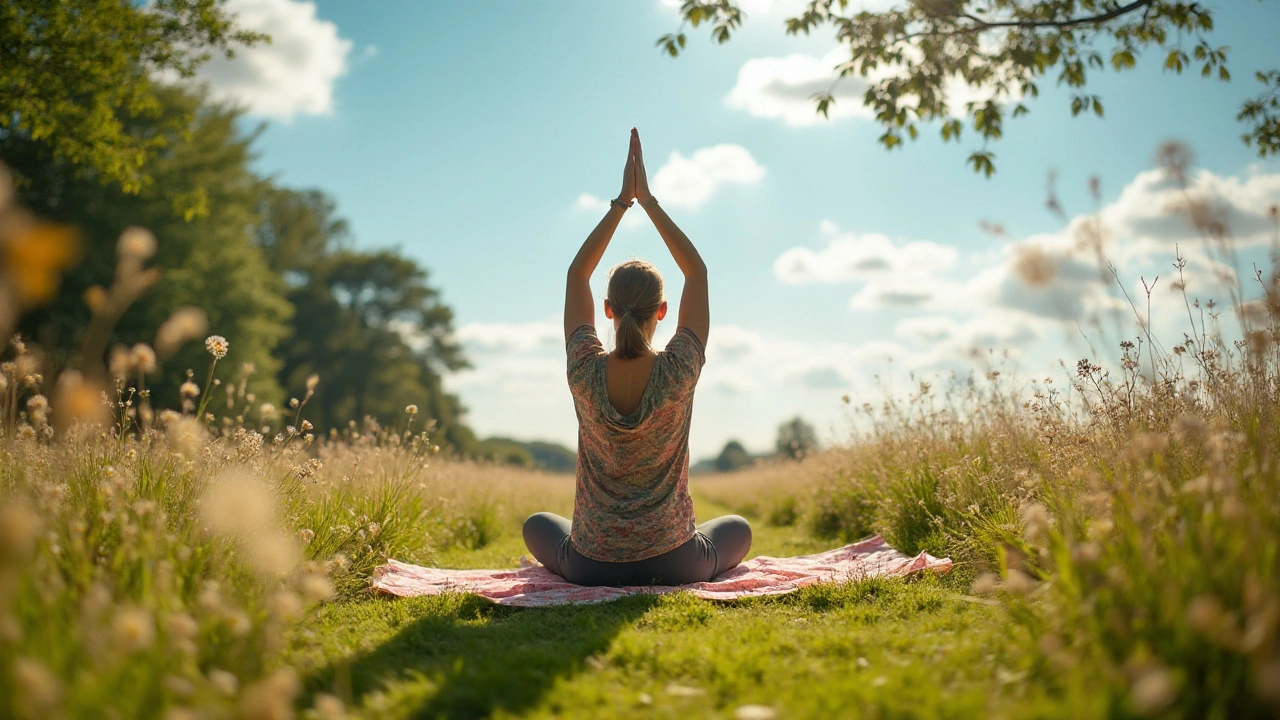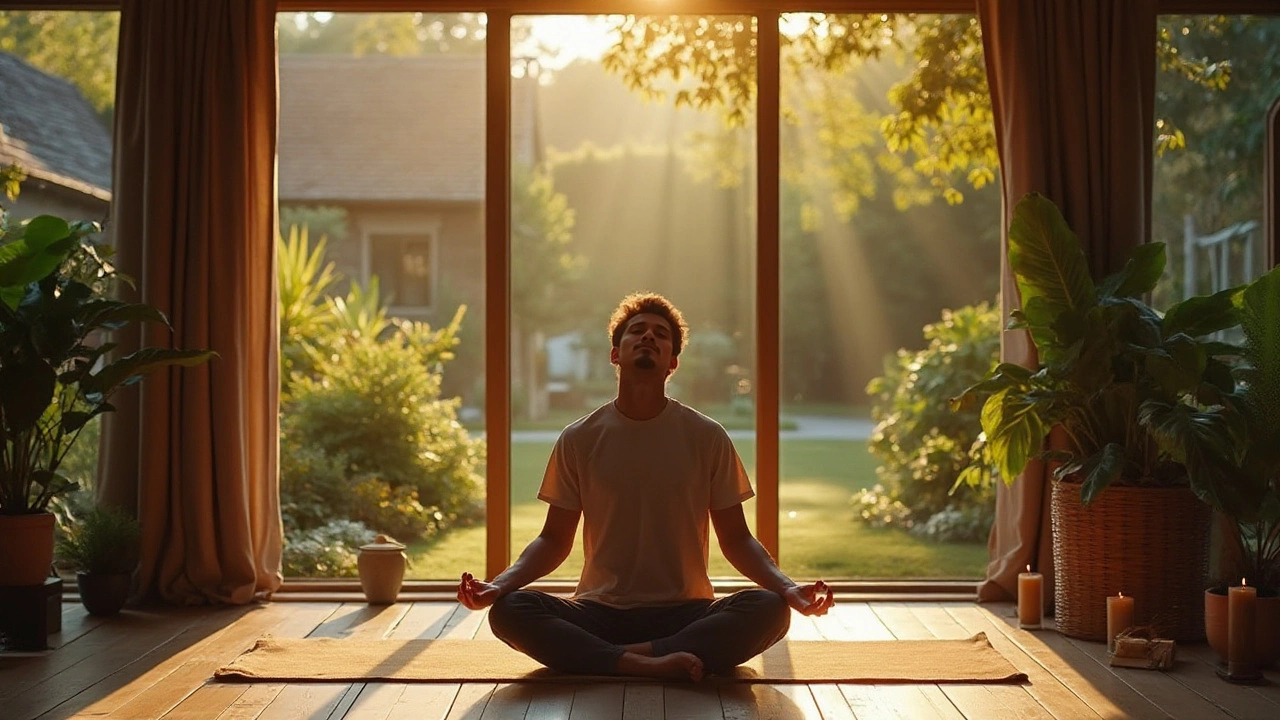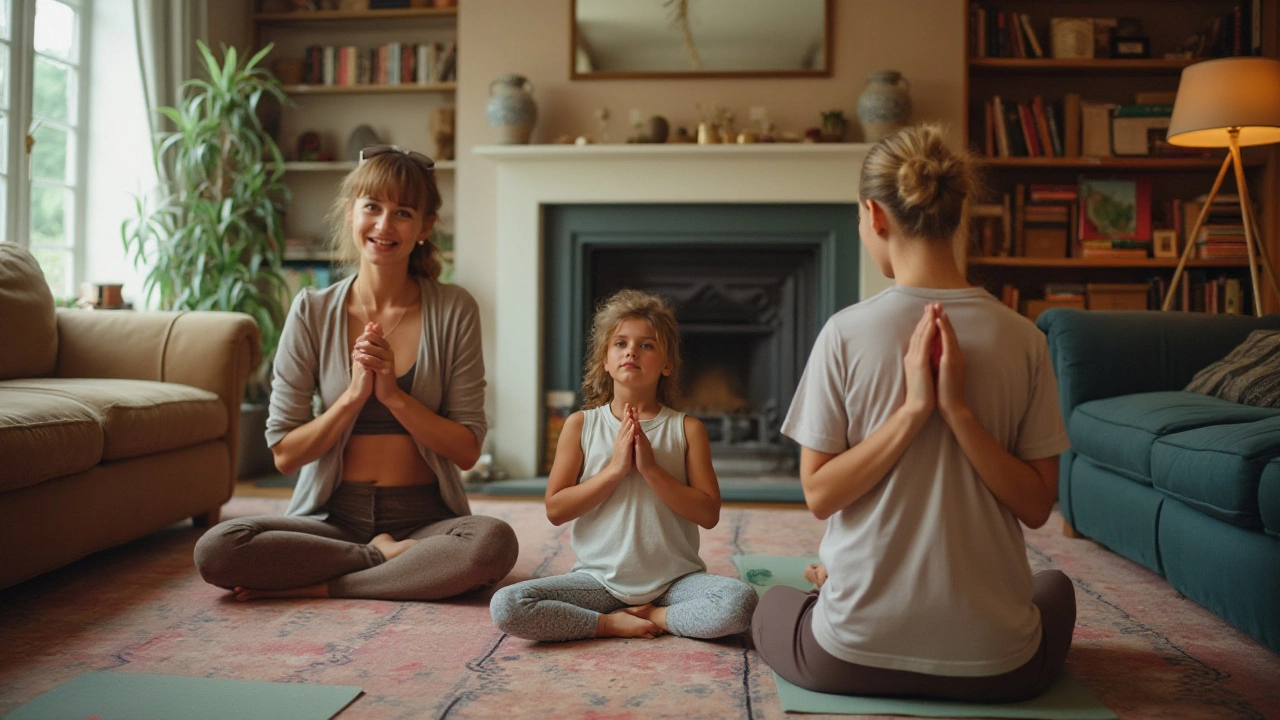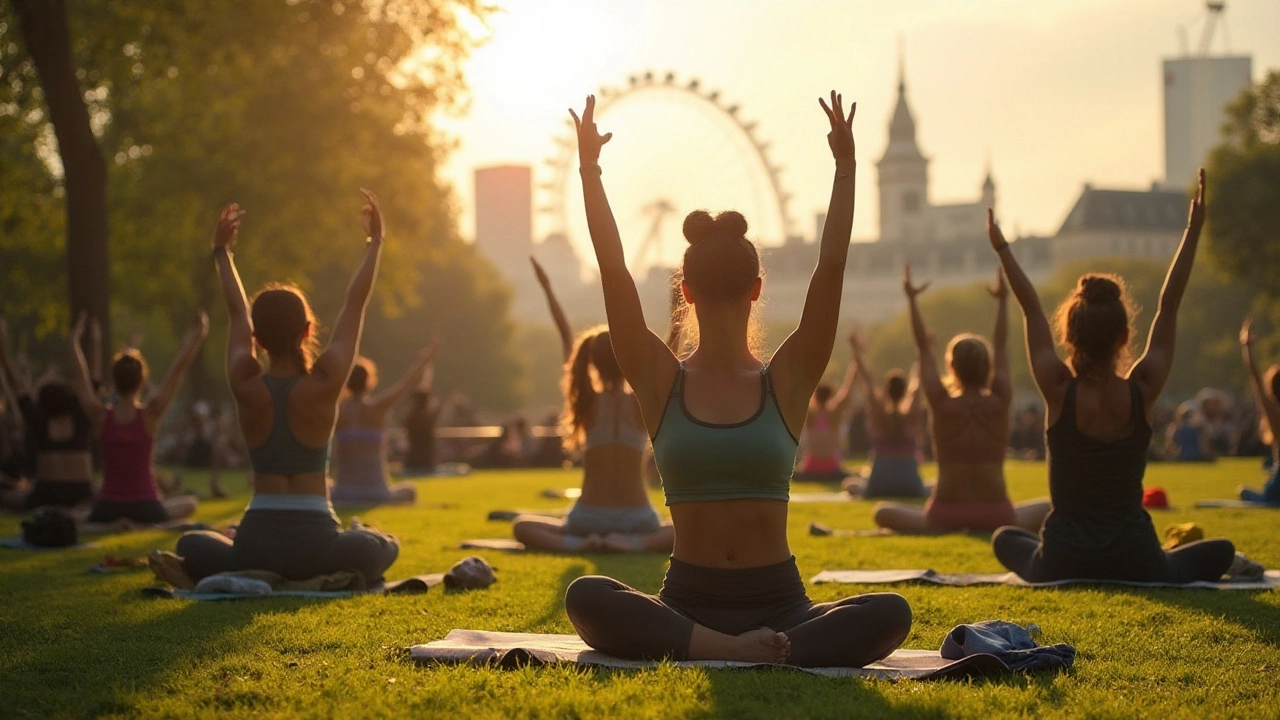
Taking on a 30-day yoga challenge can be a transformative experience, offering more than just physical benefits. This month-long commitment has the potential to uplift your spirit, clear your mind, and enhance the connection between body and breath. Yoga is about more than stretching; it invites a holistic lifestyle improvement.
Set against this backdrop of self-care and personal growth, these thirty days can teach you beyond the mat. By setting aside time each day, you encourage a habit of mindfulness and discipline that infiltrates other areas of life. Welcome to a personal voyage of discovery and improvement.
Physical Benefits
Embarking on a yoga challenge over 30 days opens up a world where flexibility, strength, and balance eagerly await their blossom. As muscles stretch and lengthen, mobility becomes your ally, making even your day-to-day movements feel easier and more graceful. Research has consistently pointed out that engaging in regular yoga practice improves flexibility by up to 35%, particularly in the hips, shoulders, and back. This enhanced limber state diminishes the risk of injury in other physical activities and supports a full range of motion across various joints.
While flexibility is certainly a desirable outcome, strength shouldn't take a back seat in this narrative. With postures such as the plank, warrior poses, and downward dog being staples in many yoga sequences, core strength and overall muscle tone benefit tremendously. A regular 30-day yoga routine fosters the development of lean, functional muscle strengthened by compound, bodyweight exercises that engage multiple muscle groups simultaneously. Improved balance and coordination come as additional gifts, harmonizing your body movements intuitively. Across just a month, you could notice with delight how you hold yourself straighter, walk with purpose, and even breathe more entirely, offering moments of peace with each exhale.
Interestingly, yoga introduces the art of breathing correctly. The union of breathwork, known as pranayama, with physical postures ensures you gain not only flexibility and strength but also enhanced lung capacity and cardiovascular health. Studies reveal that pranayama can reduce blood pressure and improve circulation by engaging deep diaphragmatic breathing. Mindful breathing transfers oxygen more efficiently to your organs and tissues, vitalizing your entire being. A life filled with mindful inhalations and exhalations brings assurance, grounding one’s presence and tethering the mind to the body.
On a structural level, yoga doesn’t only sculpt the surface muscles but importantly aligns deeper supporting tissues. By focusing on continuous practice during a 30-day yoga endeavor, you’re encouraging better posture and minimized discomfort from habitual slouches or sits. For anyone dealing with chronic back pain, like countless people today, this is a natural modal of relief that does not involve invasive procedures or reliance on medications.
"Yoga allows you to find an inner peace that is not ruffled and riled by the endless stresses and struggles of life," said renowned teacher B.K.S. Iyengar, illuminating the infinite aspects of wellness that unfold with every session.
Let’s not forget the impact yoga has on weight management. Although less intense than some cardio workouts, yoga’s integration of movement and mindfulness is proven to engage metabolism, facilitate fat burn, and regulate hormones, all integral to reaching or maintaining a healthy weight. According to a national health interview survey, individuals practising yoga show improved dietary choices—a testament that yoga benefits smoothly thread into nutritional mindfulness, crafting a healthier lifestyle outright.

Mental and Emotional Impact
Engaging in a 30-day yoga challenge has profound effects on both the mind and emotions, offering much-needed introspection and balance. This immersive commitment not only enhances physical health but nurtures the mind, becoming a sanctuary from the noise of everyday life. The practice of yoga is known to reduce stress levels significantly. Regular sessions of mindful breathing and meditative posture work together to diminish the level of cortisol, the stress hormone. Such reduction leads to a feeling of calm that permeates through your day, making routine tasks feel less taxing and your demeanor more patient.
Practicing yoga regularly encourages mental clarity, as the focus required on the mat transfers to daily life decisions and problem-solving skills. This clearer mindset is often attributed to increased mindfulness, a cornerstone of yoga. As you dedicate time each day to yoga, the practice challenges you to stay present. This presence in the moment helps diminish anxiety and overthinking. Studies have shown that consistency in such practices can lead to a decrease in symptoms for those dealing with anxiety or depression. As B.K.S. Iyengar once said,
"Yoga cultivates the ways of maintaining a balanced attitude in day-to-day life and endows skill in the performance of one’s actions."
Emotionally, yoga acts as a healing balm, fostering feelings of tranquility and acceptance. This is achieved through a combination of movement and mindful breathing, which triggers a relaxation response in the body. As you progress through your yoga routine, you may find yourself better equipped to handle life's curveballs. Consistent practice helps strengthen your emotional resilience, allowing you to respond rather than react to stress or adverse events. Uniting the body and mind through yoga creates a harmonious flow of positive energy within, resulting in a more positive outlook on life.
Further evidence supports yoga's impact by showcasing how the practice can enhance emotional intelligence, a crucial skill for navigating relationships and professional environments. This emotional boost is linked to the endorphins released during practice, which lift spirits and foster a sense of connection to oneself and others. Group classes or online communities offer an additional layer of support, creating a sense of belonging and mutual encouragement, which can be incredibly beneficial during emotional lows.
In a world where mental health is paramount, the emotional impacts of a 30-day yoga stint are invaluable. Every stretch and savasana serve as reminders of self-love and awareness in a landscape often dominated by distraction. The mental space created by the practice encourages introspection and growth that goes beyond the confines of the mat. Your mental journey during this month is not just about achieving poses; it’s a dialogue with oneself, an exploration of the mind’s capabilities, and a celebration of personal evolution.

Creating a Sustainable Routine
The heart of any lasting yoga routine is sustainability. To create practices that endure beyond the initial enthusiasm, it's crucial to integrate them into your daily life with intention and realism. Start by evaluating your current schedule and look for pockets of time that you could dedicate to your practice. Mornings are often recommended, as they allow you to center yourself before the day's challenges unfold. However, the best time for yoga is when you can consistently show up on the mat, whether it's dawn, dusk, or any time in between. Remember, consistency is key, but flexibility in timing helps maintain enthusiasm and adaptation to life's inevitable unpredictability.
Once you identify when you'll practice, consider curating a space at home that invites tranquility and focus. Your surroundings can significantly influence your ability to remain motivated, so think about lighting, scents, and noise levels. This space doesn’t require grandiosity; sometimes, a simple corner with a mat and perhaps a plant or two is enough to inspire a sense of peace. As you develop this habit, it's helpful to vary your sessions to keep them fresh. Incorporating various styles, such as Hatha for a gentle stretch, Vinyasa for a fast-paced sequence, or Kundalini for its spiritual depth, will prepare you for different moods and energy levels.
Some practitioners find it beneficial to journal along with their practice. This can mean noting progress, new insights, or sudden emotions that arise post-session. Journaling not only maps your journey but can also highlight areas needing more attention, letting you consciously steer your development. Books, articles, or even short courses about the philosophy behind yoga may deepen your understanding and keep your interest alive, providing rich soil for growth.
Accountability can be another powerful motivator. Consider partnering with a friend who shares similar wellness goals. Practicing together, even virtually, fosters a sense of community and support. There’s a remarkable strength in shared experiences and goals, and sometimes the companionship through texts or video calls is enough to push you onto the mat on days you’d rather not. Sharing tips, praise, and achievements makes this journey feel less solitary and more like a shared adventure.
Jared Leto once said,
"Do what you love, and if it's not something you love, make it something you love. Enjoyment is what transforms routine into ritual."Embracing this mindset infuses joy into repetition, which is essential for a successful course. On a similar note, celebrating small victories along the way reinforces your progress. Recognizing milestones – a week of consistent practice or mastering a challenging pose – fuels the motivation needed to press on during less inspired times.
An achievable goal is gradually to include meditation sessions alongside your asanas, no matter how brief. Starting with merely five minutes post-exercise can slowly evolve into longer durations, nourishing both your mental and physical well-being. This integral approach aligns with one of yoga’s goals: a union of mind and body that translates into a harmonious existence. Using tools like mindfulness apps, guided meditations, or simply being in silence can significantly elevate your experience. As shown in a 2022 study, combining yoga with meditation has shown a 50% increase in stress reduction compared to practicing yoga alone.
Yoga challenge: a dance with time, uncovering resilience and patience. Yield to your journey, listen to your body, and embrace the transformations. This isn't just a month-long commitment but an invitation to a lifelong practice that continuously evolves, nurtures, and empowers.

Tips for Success
Embarking on a 30-day yoga journey requires a thoughtful approach to maximize benefits and keep your enthusiasm alive. A successful yoga practice is more than just discipline; it’s about embracing a new lifestyle. To stay motivated over these 30 days, you might find it helpful to create a calming space for your practice. Dedicate a corner of your home to your yoga mat, where you can unwind and escape the daily hustle. Transform this space with touches of inspiration that resonate with you—a gentle scent from a candle, soothing music, or even an inspiring quote. Setting the mood can enhance your practice and make it something you look forward to every day.
Staying consistent is key to experiencing the full spectrum of yoga benefits. It's important to set realistic goals and gradually build them up. If you’re new to yoga, start with short sessions to build endurance and comfort with different postures. You can then increase duration and complexity as you become more confident. Many practitioners find success by pairing their yoga challenge with a journal. Consider keeping a record of your experiences, noting changes you notice both physically and mentally. Reflecting on your growth can be incredibly motivating and provide insights on how yoga is serving your life.
It’s important to remember that yoga is personal, and everyone’s journey is unique. Having said that, the right teacher can profoundly impact your practice. If possible, attend a few classes with different instructors until you find one whose style and philosophy resonate with you. Many highly respected instructors suggest focusing on the quality of breath as a guide to your practice. In an interview with Yoga Journal, the esteemed yoga instructor Rodney Yee emphasized, “The breath is the first and last teacher. It’s a clue into your state of mind and how the posture is affecting you.” When you maintain awareness of your breath, you cultivate presence, which enriches every session.
Utilizing technology can also be beneficial. There are countless apps and online platforms offering classes ranging from beginners to advanced. Platforms such as Yoga International or Yoga Download provide structured 30-day programs that keep things fresh and challenging. While virtual classes can fit your schedule perfectly, they also give you the liberty to practice at your own pace and explore various styles—from Vinyasa to Hatha and even restorative practices. Challenging yourself occasionally with a different style or new posture keeps the practice exciting and tests your limits safely.
Achieving success in the yoga challenge involves balancing ambition with patience. Accept that not every day will be perfect. The journey will involve days where energy is low, or you might feel less enthusiastic about practicing. This is natural, and it’s crucial to listen to your body. Consider these moments as an opportunity for gentler practices, focusing more on meditation and breathing exercises. Yoga is as much about nurturing your mind as it is about physical prowess. By following these tips, you'll likely discover that each day offers a new lesson, deepening your connection to yourself and to your practice.
